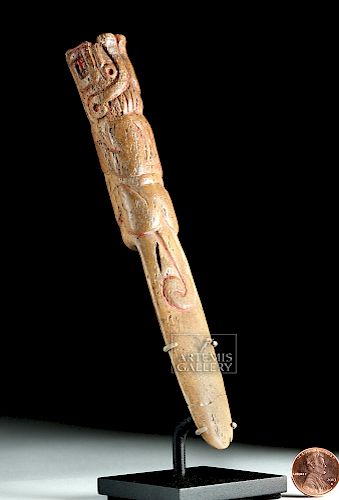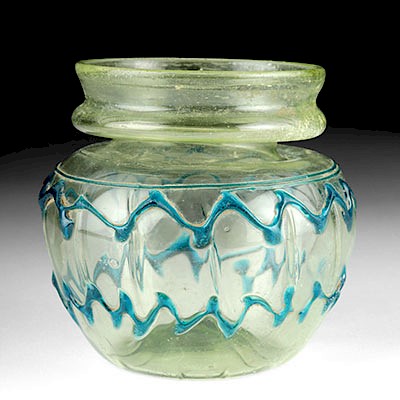Fine Chavin Bone Drug Spatula w/ Carved Jaguar
Lot 111
About Seller
Artemis Gallery
686 S Taylor Ave, Ste 106
Louisville, CO 80027
United States
Selling antiquities, ancient and ethnographic art online since 1993, Artemis Gallery specializes in Classical Antiquities (Egyptian, Greek, Roman, Near Eastern), Asian, Pre-Columbian, African / Tribal / Oceanographic art. Our extensive inventory includes pottery, stone, metal, wood, glass and textil...Read more
Estimate:
$1,900 - $2,850
Absentee vs Live bid
Two ways to bid:
- Leave a max absentee bid and the platform will bid on your behalf up to your maximum bid during the live auction.
- Bid live during the auction and your bids will be submitted real-time to the auctioneer.
Bid Increments
| Price | Bid Increment |
|---|---|
| $0 | $25 |
| $300 | $50 |
| $1,000 | $100 |
| $2,000 | $250 |
| $5,000 | $500 |
| $10,000 | $1,000 |
| $20,000 | $2,500 |
| $50,000 | $5,000 |
| $100,000 | $10,000 |
| $200,000 | $20,000 |
About Auction
By Artemis Gallery
Aug 16, 2018
Set Reminder
2018-08-16 10:00:00
2018-08-16 10:00:00
America/New_York
Bidsquare
Bidsquare : Clearance Sale - Ancient / Ethnographic Art
https://www.bidsquare.com/auctions/artemis-gallery/clearance-sale---ancient-ethnographic-art-3368
These lots are going, going, gone... plus a nice selection of lots brand-new to auction! Artemis Gallery info@artemisgallery.com
These lots are going, going, gone... plus a nice selection of lots brand-new to auction! Artemis Gallery info@artemisgallery.com
- Lot Description
**Originally Listed At $1000**
Pre-Columbian, North Coast Peru, Chavin, ca. 1200 to 500 BCE. A beautiful and finely-detailed drug spatula, hand-carved from human bone, with an incredible carving of an ornate jaguar on one end. The other end of the animal has been hollowed out, with much of the bone removed to create a smooth, gently concave scooping surface. The decorated end is densely carved, with a sinuous tail and slender recumbent body on one end, and terminating in the feline visage which displays rounded eyes, flared nostrils, and bared fangs. The face and body are embellished with both bright and pale red cinnabar pigment. An exquisite example from the ancients of Northern Peru! Custom museum-quality display stand included. Size: 0.875" W x 6.4" H (2.2 cm x 16.3 cm); 6.75" H (17.1 cm) on included custom stand.
Spatulas like this one were used in the ingestion of hallucinogenic drugs, a crucial component of Chavin religious practice. The symbolism of the half-man, half-jaguar figure was important to the Chavin people. The center of their major urban center is Chavin de Huantar, a massive, flat-topped pyramid, surrounded by lower platforms. Between 1200 and 500 BCE the pyramid space was used for religious ceremonies. The Old Temple, constructed very early in the history of the site, consists of a series of passageways built around a circular courtyard; within were carved stone monuments showing jaguars, serpents, and other figures with transformative and/or anthropomorphic figures. At the very center is a towering stone stela depicting an anthropomorphic figure with a jaguar head and a human body, believed to be Lanzon, the chief deity of Chavin. Researchers believe that worshippers ingested hallucinogenic drugs, in part using spoons like this one, and then were led in the dark through the labyrinthine passageways before entering the central courtyard and coming abruptly face-to-face with the snarling features of the god.
For an example of a Chavin jaguar drug spatula of a different form, please see The Metropolitan Museum of Art, accession number MKW-81384: https://www.metmuseum.org/art/collection/search/722371
Provenance: private Hawaii, USA collection; ex-private H. J. Westermann collection, Germany, acquired between 1960 and 1970
All items legal to buy/sell under U.S. Statute covering cultural patrimony Code 2600, CHAPTER 14, and are guaranteed to be as described or your money back.
A Certificate of Authenticity will accompany all winning bids.
We ship worldwide and handle all shipping in-house for your convenience.
#132556Repair to tip of spatula with small chips and light adhesive residue along break lines. Surface wear and abrasions commensurate with age and use as expected, normal ossification, light discoloration, fading to red cinnabar accents and carved details in some areas, with small nicks to spatula tip and animal body. Light earthen and mineral deposits throughout.Condition
- Shipping Info
-
All shipping is handled in-house for your convenience. Your invoice from Artemis Gallery will include shipping calculation instructions. If in doubt, please inquire BEFORE bidding for estimated shipping costs for individual items.
-
- Buyer's Premium



 EUR
EUR CAD
CAD AUD
AUD GBP
GBP MXN
MXN HKD
HKD CNY
CNY MYR
MYR SEK
SEK SGD
SGD CHF
CHF THB
THB















